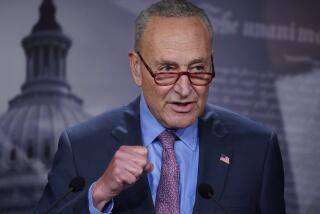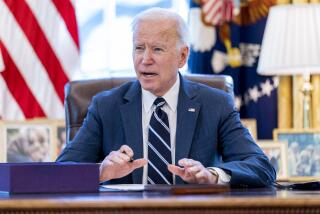Jobs, energy key to Obama stimulus plan
- Share via
WASHINGTON — President-elect Barack Obama is crafting a financial stimulus plan far more ambitious than a quick cash infusion, viewing it as a way to create jobs in a struggling economy and push the nation toward improved healthcare and roads and clean energy.
In hopes of attracting a share of the billions of dollars in stimulus money, special interests and industry representatives have been meeting with the Obama team and recasting their proposals for federal funding as engines of economic recovery.
In private discussions with Obama’s transition aides, interest groups are hearing that the president-elect wants proposals that could employ people right away.
Congressional leaders say a stimulus plan could cost $400 billion to $700 billion -- figures the Obama team does not dispute. Those numbers dwarf anything the House had been considering before Obama’s victory. In recent years, federal stimulus packages sometimes amounted to giving Americans checks, with a goal of stoking consumer spending.
But Obama hopes to launch a stimulus program that helps drive the agenda of his presidency: improving the nation’s power grid in ways that reduce carbon emissions and cut energy costs, shoring up roads, bridges and tunnels, and computerizing medical records so that doctors have up-to-date information on patients.
Such health information-technology initiatives enjoy bipartisan support in Congress, though disagreement over guaranteeing the privacy of patient records has proved to be an obstacle in the past.
The recession has propelled a stimulus package to the top of Obama’s agenda. The government reported Friday that the U.S. economy lost 533,000 jobs in November and the unemployment rate climbed to 6.7%, its highest level in 15 years.
Obama has said he wants a stimulus bill passed as soon as possible. But an aide said Friday that, because of the broad scope of the president-elect’s plans, waiting until the new Congress convenes next month might be more realistic.
House Speaker Nancy Pelosi (D-San Francisco) has said she hopes to land a bill on Obama’s desk soon after his Jan. 20 inauguration.
But the Obama team is not expecting to reverse the nation’s job losses during his first year in office. The recession is so severe that the economy probably will shed jobs in 2009 even with a stimulus in place, his aide said. Any turnaround might not come until 2010.
Speaking on condition of anonymity because he was not authorized to talk publicly, the aide said: “Given the magnitude of the problems, you’re going to need a large plan. Much of what we would do is double duty, with the effect of helping aggregate demand today but also enhancing the productivity of the economy for years and decades to come.
“So a lot of what this entails is taking a look at the priorities he set and the ideas he talked about during the campaign and asking, which of these can very naturally be done over a short time horizon?” the aide said. “Green jobs, healthcare technology and infrastructure fit that.”
In recent weeks, Obama aides have been privately consulting a range of interest groups about economic recovery ideas.
Aides to California Gov. Arnold Schwarzenegger met with John Podesta, who is helping manage Obama’s transition, and Jason Furman, an Obama economic advisor, to make the case for more spending on roads, ports and other projects.
Schwarzenegger’s office estimates that it could initiate $28 billion worth of infrastructure projects within four months -- meeting Obama’s objective of reducing unemployment while improving California’s aging transportation network.
David Crane, a Schwarzenegger advisor who attended the meeting, reported a positive reception from the Obama team.
“We wanted to ensure they were aware that infrastructure investment could be done in a meritorious way, that billions’ worth of projects are ready to go . . . and that infrastructure investment could be deeply stimulative to employment,” Crane said. “Equipment could be ordered and shovels could be in the ground virtually immediately. They were talking about the same concepts.”
Environmentalists met with Obama transition aides two weeks ago and laid out a series of long-term projects that included building new power transmission lines. But the Obama team, led by former Environmental Protection Agency Administrator Carol Browner, made it clear that speed was a crucial consideration. Obama aides urged the environmentalists to draw up a set of job-creation plans that could be put in place more quickly.
The group responded by submitting a list of dozens of projects that could begin in as little as one month.
“They actively and avidly have been thinking about good ideas for environment-enhancing job programs that are ready to go,” said Carl Pope, the Sierra Club’s executive director, who attended the meeting. “Carol Browner brought it up and said, ‘We need ideas. This is the first thing we have to put together because this is the first thing the president-elect plans to do.’ ”
Among the projects that could be included in the stimulus package are power meters that provide consumers with an early and more accurate readout of power usage, more energy-efficient roofs and improvements to the nation’s power grid, according to the Obama transition team.
Interest groups and industries are quickly shifting gears.
For example, the roofing industry wants tax incentives that encourage people to replace roofs that, with new technology, can be made more energy-efficient.
Craig Silvertooth, executive director of the Center for Environmental Innovation in Roofing, said roof replacement and insulation would generate more jobs and increase the energy efficiency of buildings. But he conceded that the idea might stagnate on Capitol Hill under other circumstances.
“Without the stimulus package, I don’t think it would be politically feasible to consider something like that given the tight budget constraints,” he said.
Obama’s ideas largely comport with what congressional leaders want done. John Lawrence, Pelosi’s chief of staff, said she was interested in expanding the concept of infrastructure repair beyond its traditional focus on brick-and-mortar projects to initiatives such as expanding the electric grid and improving access to broadband services, as well as health initiatives.
“The speaker is adamant that it will be a 21st century jobs component,” Lawrence said. “We’re not just nostalgic for the New Deal, we’re not just looking at make-work jobs. It will entail getting the economy in shape for the 21st century.”
Discussions about folding healthcare provisions into the stimulus package have been increasing on Capitol Hill over the last week, according to Democratic aides and healthcare officials in Washington. Several senior Democrats, including Pelosi, already support additional federal aid to states for Medicaid, a top priority for state leaders struggling to balance budgets.
The National Governors Assn. has estimated that as much as $40 billion over the next two years is necessary.
Also under consideration is a major expansion of the popular State Children’s Health Insurance Program, which Bush vetoed in 2007. A boost in federal aid to cover more children would send billions of dollars out to states, which administer the program.
Some Democrats believe, however, that expansion of the program, known as SCHIP, should be passed separately so the Obama administration and congressional Democrats can claim it as a major accomplishment of the new administration’s first 100 days.
--
The Washington bureau’s Noam N. Levey and James Oliphant contributed to this report.
janet.hook@latimes.com
--
(BEGIN TEXT OF INFOBOX)
Upgrading America
An early glimpse of highlights from President-elect Barack Obama’s stimulus plan, which could range from $400 billion to $700 billion. The stimulus might include three categories of spending: healthcare, infrastructure and energy:
HEALTHCARE
Obama wants the stimulus to include money to computerize medical records, so doctors have more up-to-date information about patients. Such a reform could improve healthcare delivery and cut costs.
INFRASTRUCTURE
Obama wants the stimulus to underwrite public works projects (for example, road, bridge, tunnel improvements) that could begin immediately. In part, the idea is to create jobs quickly.
ENERGY
The package might include funds for conserving energy in homes. That may involve installing “smart meters” that would give homeowners an early and more accurate readout of their power usage. Obama wants more energy-efficient roofs and improvements to the nation’s power grid.
Source: Los Angeles Times
More to Read
Get the L.A. Times Politics newsletter
Deeply reported insights into legislation, politics and policy from Sacramento, Washington and beyond. In your inbox twice per week.
You may occasionally receive promotional content from the Los Angeles Times.











